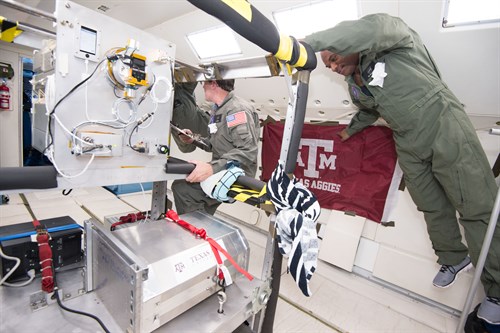
Dr. Cable Kurwitz and three Texas A&M Undergraduate Engineering students recently completed a successful flight test program aboard NASA’s reduced gravity aircraft of the Demonstration of a variable heat rejection (DoVR) system. The technology relies upon the exchange of liquid and a non-condensible gas between selected radiator coolant transport lines and a vortex phase separator. The reduced gravity aircraft flight provided by NASA’s Flight Opportunities Program allowed for demonstration of fluid handling in a near zero gravity environment and served as a precursor flight for the upcoming suborbital mission. Further news stories can be found here, here, here, and here.
Using Eductor to Remove Liquid from Transport Line
A novel approach to clearing liquid from radiator lines in reduced gravity was recently demonstrated. THe approach uses a passive eductor pump and phase separator both of which have operated successfully in reduced gravity. A video of a single line being cleared using an eductor shows how effective the removal of liquid can be in an earth gravity environment. Since the dominant flow regime will be slug in zero gravity rather than slug/stratified in Earth gravity, performance should be improved. Using an appropriate arrangement of valves, eductor, and phase seperator, one could remove liquid from selected portions of the radiator which would change its heat transfer performance. A montage of the clearing process for one of the tests is shown below.


